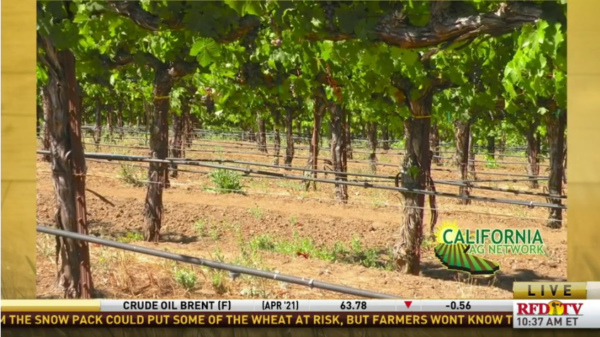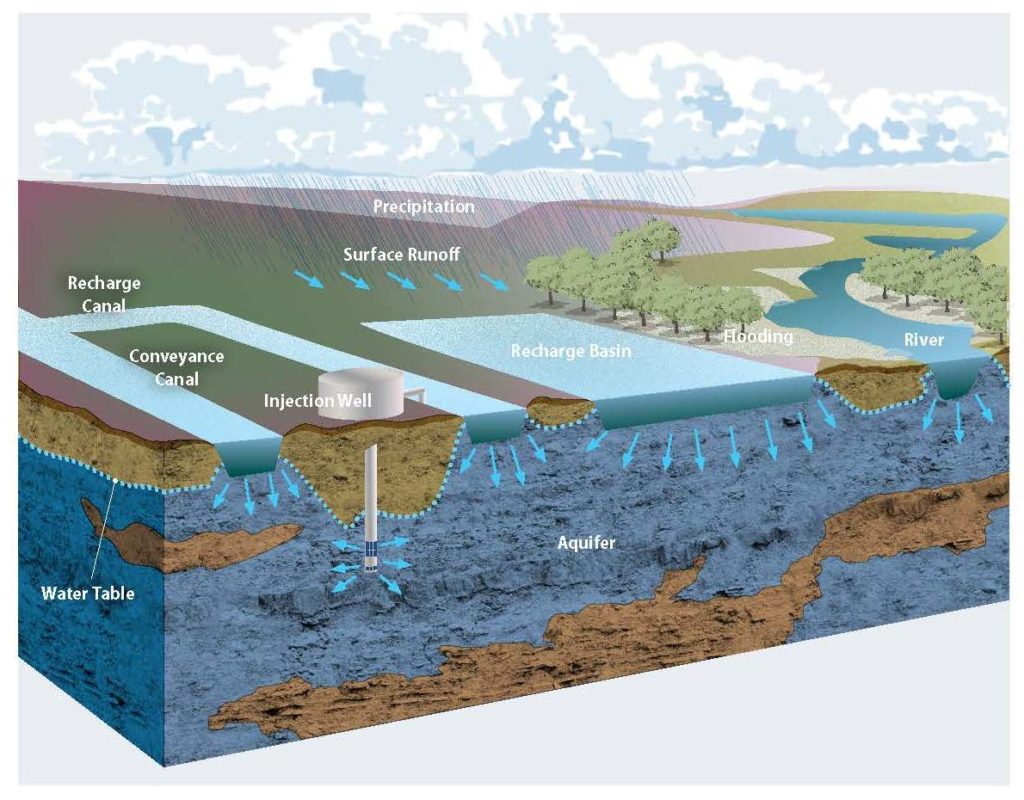 “Drought has become an issue in California, and one way to help that are vineyards. California Ag Net explains how researchers are using farmland to recharge groundwater.”
“Drought has become an issue in California, and one way to help that are vineyards. California Ag Net explains how researchers are using farmland to recharge groundwater.”
Watch video segment from RFD TV here: Using vineyards to recharge California’s groundwater
For more on groundwater recharge, visit the groundwater recharge page at the Groundwater Exchange by clicking here.

“Efforts to boost groundwater recharge are critical to making California’s limited, and increasingly volatile, water resources go further. Recharge is playing a growing role in maintaining groundwater as an effective drought reserve and in slowing or reversing the effects of years of unsustainable groundwater pumping.
But implementing recharge projects is not easy. Water managers face a range of hurdles. Even with the Sustainable Groundwater Management Act (SGMA) on the books, and the increasing availability of technical assistance, local decision makers are left mostly to their own ingenuity to figure out how to shore up groundwater resources to meet future needs.
Many Groundwater Sustainability Agencies (GSAs) expect recharge to help them meet their responsibilities under SGMA. But the details of how they will implement recharge projects are often unclear. … “
Click here to continue reading this article at Legal Planet.

“Groundwater recharge projects already play an important role in California. That role is about to expand rapidly, as local groundwater managers begin to take more concrete actions to meet their responsibilities under California’s landmark Sustainable Groundwater Management Act (SGMA).
As we mentioned in our last post, an important part of developing a successful recharge project is securing a source of water and the legal right to use it. In that post, we described the surface water right permit options administered by the State Water Resources Control Board (Water Board) that are potentially available for new groundwater recharge projects. We also mentioned the central role of permitting, and water rights oversight more broadly, in ensuring that water diversion and use doesn’t harm other water users or uses.
But is a water right always necessary? Below we explore when a recharge project might not need a water right at all (short answer: it’s complicated…and more than a little unclear)—and why it matters. … “
Click here to continue reading from Legal Planet.
 From the Environmental Defense Fund:
From the Environmental Defense Fund:
Recharging groundwater with rain and snowmelt is one strategy water managers are embracing to help balance groundwater supply and demand and comply with the California Sustainable Groundwater Management Act.
Depending on the location, recharge can also deliver other valuable benefits, such as additional habitat for wildlife and a more resilient water supply for people.
With support from EDF, four UC Santa Barbara graduate students have developed a new mapping tool for California’s Central Valley to identify the best locations for groundwater recharge to secure these bonus benefits.
Click here to continue reading at Growing Returns.
 The U.S. Army Corps of Engineers’ (USACE) Institute for Water Resources (IWR) released a report titled Managed Aquifer Recharge (MAR) and the U.S. Army Corps of Engineers: Water Security through Resilience.
The U.S. Army Corps of Engineers’ (USACE) Institute for Water Resources (IWR) released a report titled Managed Aquifer Recharge (MAR) and the U.S. Army Corps of Engineers: Water Security through Resilience.
With the water needs of society increasing and becoming increasingly diverse, water management and planning are more challenging than ever. Water security in all its forms is as important, but seems progressively difficult to achieve. Additional water storage and flood risk management is needed, but major new surface infrastructure projects seem unlikely. Water storage underground (managed aquifer recharge, or MAR) is an alternative to augment surface storage and increase resilience of USACE projects while improving the Nation’s water security.
MAR is a term that covers artificial recharge, aquifer storage and recovery, riverbank and riverbed filtration, groundwater banking, and other mechanisms of purposeful water recharge to aquifers for later recovery. MAR use has grown rapidly over the last two decades, progressing from an often-experimental concept to a management tool used in over 1000 sites around the world.
The U.S. Army Corps of Engineers (USACE) and its partners have engaged, or considered engaging, in the use of MAR in a variety of settings and purposes, throughout the United States. These purposes include:
-
-
- Flood risk management -Recharge of floodwaters, in combination with surface storage, can dampen the flood peak.
- Aquatic ecosystem restoration – Discharging stored groundwater may help maintain timely environmental flows.
- Drought resilience – MAR can provide back-up storage for multi-year droughts without losses due to evaporation.
- Salt-water intrusion prevention – Replenishing coastal aquifers can provide additional agricultural and potable water supply while keeping salt water at a safe distance.
- Multi-purpose projects – Urban water projects can combine wastewater reuse, wetlands restoration, recreational and educational opportunities, and MAR.
This report examines how MAR has been, is being, or could be used in conjunction with USACE Civil Works water resources projects. The report summarizes some of USACE’s authorities for using MAR, provides numerous examples of USACE activities involving MAR, reviews the experience of other US government agencies and Departments, and considers how MAR can be integrated into the USACE civil works planning process and new initiatives.
The report is available for free download from the IWR Library.
Learn More
For more information, visit:
From Stanford Woods Institute for the Environment:
“Many arid regions face groundwater security and reliability challenges, such as overdraft and climate change-driven precipitation shifts. Increasingly, water managers are considering recharging aquifers using stormwater and recycled water–Managed Aquifer Recharge (MAR). These projects are hindered by a lack of tools to evaluate system design costs and trade-offs. Stanford researchers have developed AquaCharge, a planning tool that can optimize system costs and performance to help water managers make more informed decisions about how MAR can fit into water management strategies. … ”
Read this research brief here: AquaCharge: A Design Tool for Balancing Groundwater Management Trade-Offs
From Michael Campana at the Water Wired blog:
“A process of Incentivized Managed Aquifer Recharge, utilizing ownership of marketable Aquifer Recharge Units is being implemented within Idaho’s Eastern Snake Plain Aquifer. A powerful tool in establishing balanced and sustainable aquifer management, the Incentivized Managed Aquifer Recharge program could have beneficial application in suitable water basins throughout the West.
Managed Aquifer Recharge (MAR) may be defined as processes designed to move water from land surface to aquifer storage. MAR has been conducted in various locations throughout the world since ancient times. Modern MAR efforts in the western United States have been frequently documented in The Water Report (see Recharge References below). Virtually all of these efforts, however, have been undertaken by or through a governmental entity (state or municipal), or by a private entity at a local scale involving one or just a few wells. The State of Arizona created a basin-wide opportunity for crediting recharge water but this system applies only in Arizona. While localized efforts in other basins have been implemented, to date they do not provide cost-effective incentivized solutions at a basin scale.
The Recharge Development Corporation (RDC) is an Idaho corporation created for the purpose of developing infrastructure, processes, and strategies that will facilitate water retention projects to benefit residents and water users in the State of Idaho.
RDC is helping incentivize Eastern Snake Plain Aquifer entities to be involved in MAR through the application of Incentivized Managed Aquifer Recharge (patent-pending). …
Click here to read more and download article at the Water Wired blog.
 “Drought has become an issue in California, and one way to help that are vineyards. California Ag Net explains how researchers are using farmland to recharge groundwater.”
“Drought has become an issue in California, and one way to help that are vineyards. California Ag Net explains how researchers are using farmland to recharge groundwater.”



